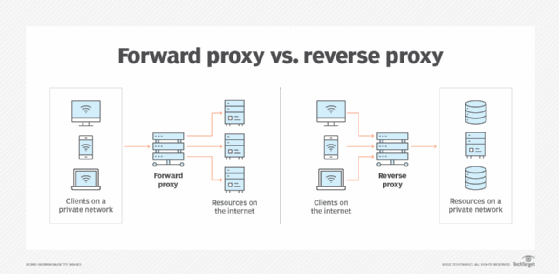Read: Class 13 Reconstructing a Cloud Attack with Splunk
-1.png?width=650&name=What%20Is%20a%20Reverse%20Proxy%3F%20(And%20Why%20Does%20It%20Matter%3F)-1.png)
A reverse proxy is a server that sits in front of web servers and applications. It acts as an intermediary for all incoming requests, routing them to the appropriate server. Reverse proxies provide functionality like load balancing, caching, authentication, and security.
A forward proxy offers numerous advantages for organizations and clients. It can filter content to restrict access to websites deemed inappropriate or unproductive. This helps enforce an organization's acceptable use policies. The forward proxy also caches frequently accessed content to improve performance for clients by reducing the need to retrieve the same resources from the Internet each time. The proxy can perform security checks like malware scanning on downloaded files and filter URLs to block unsafe sites. Furthermore, a forward proxy can provide identity and access management by authenticating clients and authorizing access based on policies. This allows businesses to control what resources each client can access.
To summarize, the key benefits of a forward proxy are:
- Content filtering.
- Performance gains through caching.
- Enhanced security through malware scanning and URL filtering.
- More robust access management for clients.

A forward proxy sits before clients and routes their outgoing requests, while a reverse proxy sits before servers and routes incoming requests to the appropriate server. A forward proxy is client-facing, while a reverse proxy is server-facing. Forward proxies are used to restrict and filter client access. Reverse proxies are used to optimize, load balance and provide security for servers.
Implementing a reverse proxy could offer numerous benefits that would improve our applications' performance, security and manageability. A reverse proxy could provide load balancing across application servers to improve scalability and uptime. It could cache static content to reduce the load on the origin servers and speed up user responses. Security features like DDoS protection, a web application firewall, and SSL termination could add an additional layer of defence. Centralizing authentication and authorization through the reverse proxy could simplify management. Furthermore, hiding the actual IP addresses of our application servers could reduce their exposure to attacks.